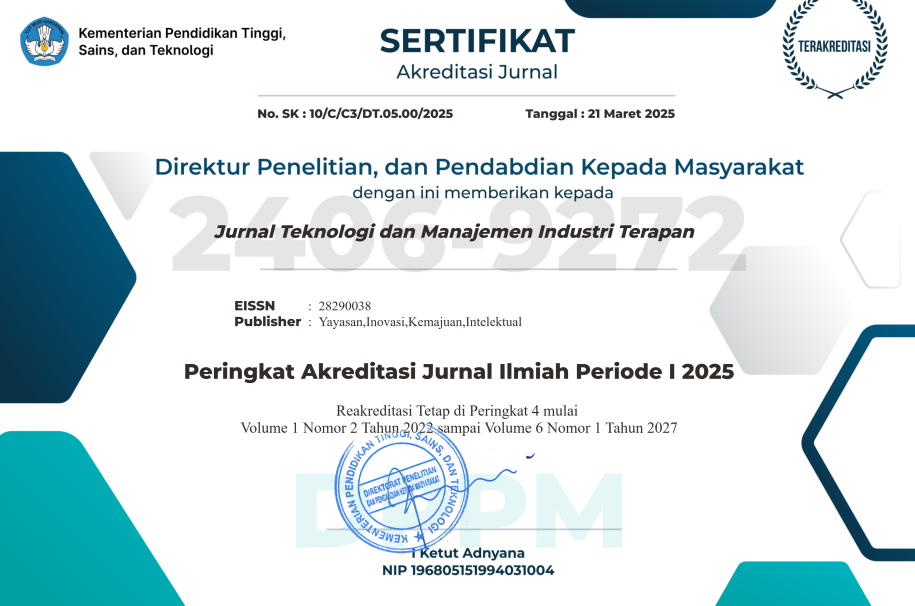Designing Ambidextrous AI Governance for Digital Transformation in Fintech Sector
DOI:
https://doi.org/10.55826/jtmit.v4i3.1042Keywords:
AI Governance, Ambidextrous Governance, COBIT 2019, Digital Transformation, Fintech, Ethical AI, Risk ManagementAbstract
The rapid integration of Artificial Intelligence (AI) in financial technology (fintech) has created an urgent need for robust governance mechanisms. While AI drives digital transformation by enabling automation, personalization, fraud detection, and operational efficiency, it also introduces critical challenges related to ethics, security, transparency, and regulatory compliance. This study proposes an Ambidextrous AI Governance Framework, grounded in the COBIT 2019 framework, to address these challenges in fintech organizations. The framework balances exploration (innovation, agility, and ethical practices) with exploitation (risk control, compliance, and operational efficiency) through five integrated governance layers: Governance, Strategic Alignment, Ambidextrous, Operational, and Compliance & Assurance. A design science research approach was employed, including a literature review, expert validation, and simulation within a controlled fintech environment. The results showed that the proposed framework improved governance maturity across COBIT domains and embedded principles of trustworthy AI, such as transparency, accountability, and fairness. This research provides a scalable and adaptable model aligned with international standards, such as ISO/IEC 42001, and regulatory frameworks, including the EU AI Act and OJK guidelines. The proposed governance design enables fintech organizations to innovate responsibly while mitigating risks, ensuring compliance, and fostering trust in AI-driven financial services.
References
ISACA, “Leveraging COBIT for Effective AI System Governance,” ISACA, 2025, [Online]. Available: https://www.isaca.org/resources/white-papers/2025/leveraging-cobit-for-effective-ai-system-governance
N. N. Putri, R. Mulyana, and T. N. Adi, “Ambidextrous AI Governance Design Based on COBIT 2019 Traditional and DevOps for TelCo ’ s Digital Transformation,” TIERS Inf. Technol. J., vol. 6, no. 1, 2025, doi: https://doi.org/10.38043/tiers.v6i1.6610.
A. A. Respati, “Reformulasi UU ITE terhadap Artificial Intelligence Dibandingkan dengan Uni Eropa dan China AI Act Regulation,” J. Usm Law Rev., vol. 7, no. 3, pp. 1737–1758, 2024, doi: 10.26623/julr.v7i3.10578.
R. C. M. Komalasari, “Enhancing Indonesia-EU Relations : Balancing AI Regulation, National Security, and Economic Growth In a Digital Age,” Politica, vol. 16, no. 1, pp. 57–74, 2025, doi: 10.22212/jp.v16i1.4725.
S. Kutscher, “The EU AI Act : Law of Unintended Consequences ?,” Technol. Regul., vol. 016, pp. 316–335, 2025, doi: 10.71265/krne7205.
S. R. R. Andriani Novi, Mulyana Rahmat, “Ambidextrous Cloud Governance Approach to Enhance TelCo ’ s Digital Transformation Using COBIT 2019 Traditional and DevOps,” Int. J. Adv. Data Inf. Syst., vol. 6, no. 2, pp. 357–375, 2025, doi: 10.59395/ijadis.v6i2.1398.
S. Aziz and N. A. Rahim, “Emerging Trend of Ambidextrous Ai-Driven Tech Ventures,” J. Theor. Appl. Inf. Technol., vol. 102, no. 21, pp. 7638–7657, 2024, [Online]. Available: https://www.jatit.org/volumes/Vol102No21/6Vol102No21.pdf
S. Han, D. Zhang, H. Zhang, and S. Lin, “Artificial Intelligence Technology, Organizational Learning Capability, and Corporate Innovation Performance: Evidence from Chinese Specialized, Refined, Unique, and Innovative Enterprises,” Sustain., vol. 17, no. 6, 2025, doi: 10.3390/su17062510.
C. van Noordt and L. Tangi, “The dynamics of AI capability and its influence on public value creation of AI within public administration,” Gov. Inf. Q., vol. 40, no. 4, p. 101860, 2023, doi: 10.1016/j.giq.2023.101860.
S. Hossain, M. Fernando, and S. Akter, “Digital Leadership: Towards a Dynamic Managerial Capability Perspective of Artificial Intelligence-Driven Leader Capabilities,” J. Leadersh. Organ. Stud., vol. 32, no. 2, pp. 189–208, 2025, doi: 10.1177/15480518251319624.
E. Papagiannidis, P. Mikalef, and K. Conboy, “Responsible artificial intelligence governance: A review and research framework,” J. Strateg. Inf. Syst., vol. 34, no. 2, p. 101885, 2025, doi: 10.1016/j.jsis.2024.101885.
A. Pratama, D. R. I. Hapsari, and L. Wulandari, “Bridging Regulation and Reality: A Comparative Study of Artificial Intelligence Regulation in the Financial Sectors,” Leg. J. Ilm. Huk., vol. 33, no. 2, pp. 307–333, 2025, doi: 10.22219/ljih.v33i2.38908.
M. Lestari, A. Iriani, and H. Hendry, “Information Technology Governance Design in DevOps-Based E-Marketplace Companies Using COBIT 2019 Framework,” INTENSIF J. Ilm. Penelit. dan Penerapan Teknol. Sist. Inf., vol. 6, no. 2, pp. 233–252, 2022, doi: 10.29407/intensif.v6i2.18104.
M. Solikhah, L. Magdalena, and M. Hatta, “Implementation of the COBIT 2019 Framework on Information Technology Governance and Risk Management (Study Case: CV. Syntax Corporation Indonesia),” Eduvest - J. Univers. Stud., vol. 4, no. 7, pp. 5922–5944, 2024, doi: 10.59188/eduvest.v4i7.1504.
M. Lestari, Y. Nataliani, and I. R. Widiasari, “Analisis Kinerja Sistem Informasi Akademik Menggunakan Framework Cobit 2019 (Studi Kasus: Sia-Sat Uksw),” JUSIM (Jurnal Sist. Inf. Musirawas), vol. 7, no. 1, pp. 1–12, 2022, doi: 10.32767/jusim.v7i1.1424.
B. Preuss, “Contemporary Approaches for AI Governance in Financial Institutions,” SSRN Electron. J., 2021, doi: 10.2139/ssrn.3773581.
T. R. McIntosh et al., “From COBIT to ISO 42001: Evaluating cybersecurity frameworks for opportunities, risks, and regulatory compliance in commercializing large language models,” Comput. Secur., vol. 144, no. November 2023, p. 103964, 2024, doi: 10.1016/j.cose.2024.103964.
D. Nurwulan, F. C. Maulana, T. Handoyo, and U. T. Digital, “Inovasi tanpa batas potensi ai dalam menciptakan sistem transaksi keuangan digital,” J. Ilm. Ekon. dan Manaj., vol. 3, no. 6, pp. 417–431, 2025, doi: https://doi.org/10.61722/jiem.v3i6.5401.
M. Lestari, A. F. Wijaya, and M. M. D. Chandra, “Enterprise Architecture Model for Smart Government Implementation,” J. Inf. Syst. Informatics, vol. 7, no. 1, pp. 78–96, 2025, doi: 10.51519/journalisi.v7i1.978.
J. F. Andry, “Performance Measurement of Information Technology Governance: a Case Study,” J. Sist. Inf., vol. 12, no. 2, p. 57, 2016, doi: 10.21609/jsi.v12i2.477.
Downloads
Published
Issue
Section
License
Copyright (c) 2025 Merryana Lestari, Agustinus Fritz Wijaya, Maria Entina Puspita, Vicky

This work is licensed under a Creative Commons Attribution-NonCommercial-ShareAlike 4.0 International License.


















